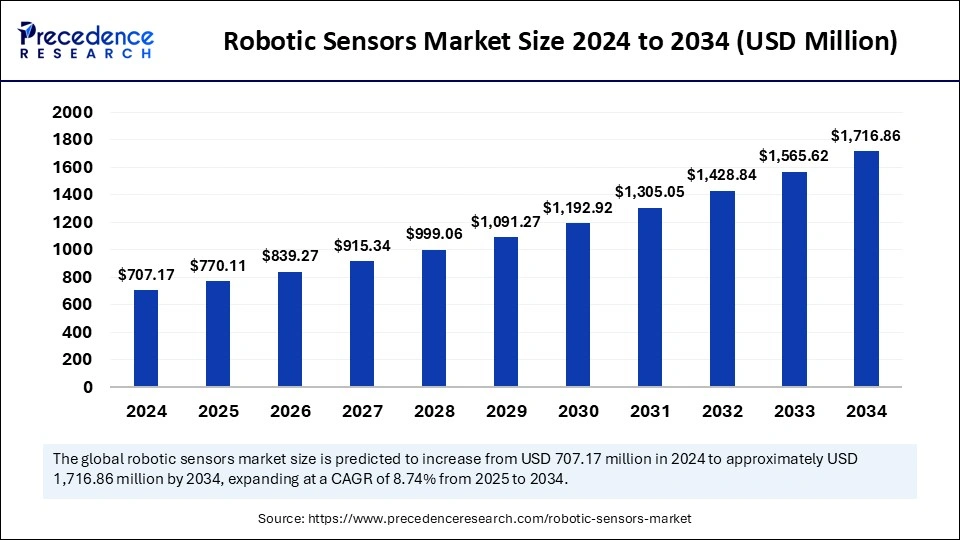The robotic sensors market is set to grow from USD 707.17 million in 2024 to USD 1,716.86 million by 2034, with an 8.74% CAGR.

Robotic Sensors Market Key Takeaways
- Asia Pacific dominated the global robotic sensors market in 2024
- North America is expected to witness the fastest growth during the forecast period.
- By sensor type, the vision sensors segment accounted for the largest market share in 2024.
- By sensor type, the force/torque sensors segment is projected to grow at the fastest rate during the assessment years.
- By application, the industrial robots segment dominated the market with the largest share in 2024.
- By application, the healthcare robots segment is set to register notable growth in the upcoming period.
- By technology, the MEMS-based segment contributed the highest market share in 2024.
- By technology, the optical segment is expected to expand at a significant growth CAGR in the upcoming period.
- By interface, the analog segment captured the biggest market share in 2024.
- By interface, the digital segment is anticipated to grow at the highest CAGR during the forecast period.
- By platform, the mobile robots segment held a significant market share in 2024.
- By platform, the industrial robots segment is projected to witness notable growth in the coming years.
Robotic Sensors Market Overview
The global robotic sensors market is expanding rapidly as automation, artificial intelligence, and autonomous systems become integral to industries such as manufacturing, logistics, healthcare, and defense.
Robotic sensors provide essential data that enable robots to navigate, detect obstacles, and interact with objects and humans safely. With the growing demand for intelligent robotics, sensor technologies such as LiDAR, infrared sensors, and haptic sensors are gaining prominence. The push for autonomous vehicles, drones, and smart robotics in various sectors is further fueling the demand for high-performance sensors capable of real-time data collection and processing.
Robotic Sensors Market Drivers
The increasing demand for autonomous robots in warehouses, hospitals, and defense applications is a major driver of the robotic sensors market. The rise of smart cities and automation in public services is also contributing to sensor adoption in robotic systems. Continuous improvements in sensor accuracy, response time, and durability have made robotic sensors more efficient and reliable, accelerating their integration into next-generation robotic systems.
Additionally, the growth of AI-powered robotics, which relies on advanced sensory data for machine learning and decision-making, is further boosting market expansion.
Robotic Sensors Market Opportunities
The rise of humanoid and assistive robots in healthcare and elder care presents lucrative opportunities for robotic sensor manufacturers. The expansion of the consumer robotics market, including robotic vacuum cleaners, lawn mowers, and personal assistants, is driving demand for cost-effective yet high-performance sensors.
The agricultural sector also holds significant potential, as farmers increasingly adopt robotic solutions for precision farming, crop monitoring, and autonomous machinery. Furthermore, advancements in neuromorphic computing and bio-inspired robotics are expected to create new applications for robotic sensors.
Robotic Sensors Market Challenges
The high cost of LiDAR and other advanced sensing technologies remains a challenge for mass adoption. Technical limitations, such as sensor drift, latency, and sensitivity to environmental factors, can impact performance and reliability.
The complexity of integrating multiple sensors into a single robotic platform also requires advanced processing capabilities and sophisticated algorithms, increasing development costs. Additionally, regulatory uncertainties surrounding autonomous robotic systems and AI-driven decision-making pose challenges for widespread implementation.
Robotic Sensors Market Regional Insights
North America leads the robotic sensors market due to its strong focus on AI research, robotics innovation, and industrial automation. Europe follows closely, with growing investments in robotics for manufacturing and healthcare.
The Asia-Pacific region, particularly China, Japan, and South Korea, is experiencing rapid market growth driven by government initiatives and a strong industrial automation sector.
Latin America and the Middle East are gradually adopting robotic sensors, particularly in infrastructure development and logistics.
Robotic Sensors Market Recent Developments
Recent innovations include the development of ultra-sensitive bio-inspired tactile sensors, AI-powered vision systems, and LiDAR-based navigation solutions for autonomous robots. Companies are investing in sensor miniaturization and energy-efficient designs to enhance battery life and performance in mobile robots. The integration of blockchain and cybersecurity solutions in robotic sensing is also gaining attention to address data privacy concerns.
- In June 2024, an innovative tactile sensor which is omnidirectional for robotic hands was launched by ETRI which detects pressure exerted by nay entity from any direction. These sensors further offer high precision and longevity as they are integrated with LED indicators and flexible air chambers.
- In June 2024, in India a leading player-HIKROBOT unveiled machine vision photoelectric sensors in India to strengthen its portfolio of robot sensors. It helps upgrade features of robotic sensors, like machine vision, resistance to climatic factors, and long-range detection
Robotic Sensors Market Companies
- Fanuc Corporation
- Baumer Group
- Honeywell International Inc.
- Futek Advanced Sensor Technology Inc.
- ATI Industrial Automation Inc.
- Infineon Technologies
- Omron Corporation
- Sensata Technologies Inc.
- TE Connectivity Ltd.
- Tekscan Inc.
Segments Covered in the Report
By Sensor Type
- Vision Sensors
- Force/Torque Sensors
- Inertial Measurement Units
- Encoders
- Laser Sensors
- Ultrasonic Sensors
By Application
- Industrial Robotics
- Healthcare Robotics
- Military and Defence Robotics
- Consumer Robotics
- Commercial Robotics
By Technology
- MEMS-based
- Optical
- Capacitive
- Inductive
- Piezoelectric
By Interface
- Analog
- Digital
- Wireless
- Fieldbus
By Robotic Platform
- Mobile Robots
- Industrial Robots
- Collaborative Robots
- Humanoid Robots
By Region
- North America
- Europe
- Asia Pacific
- Latin America
- Middle East and Africa (MEA)
Ready for more? Dive into the full experience on our website!
